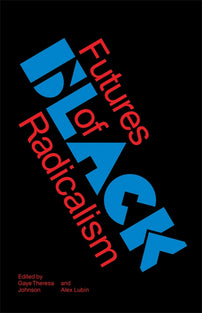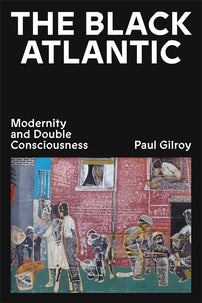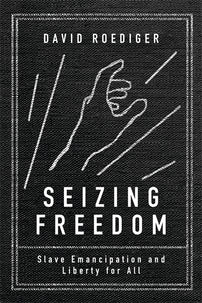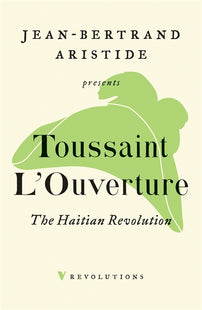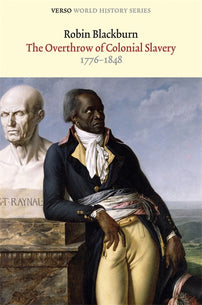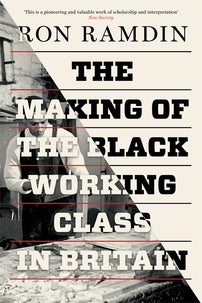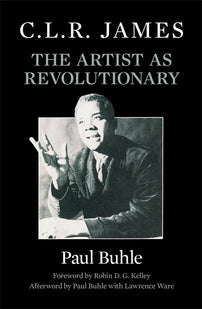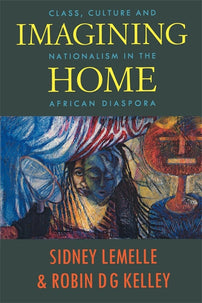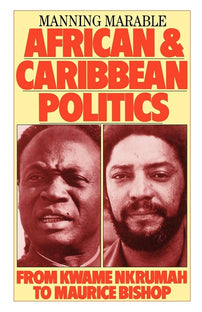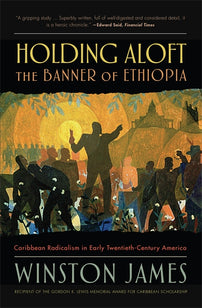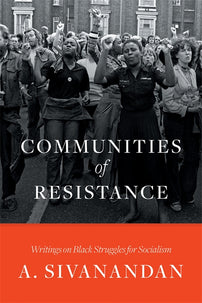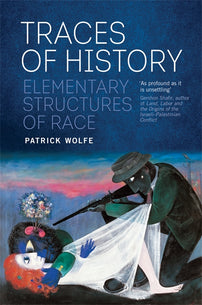Coming to Terms: The Third World and the Dialectic of Imperialism
"How are we to conceptualise what we [black peoples] were, what we are, what we are becoming?"
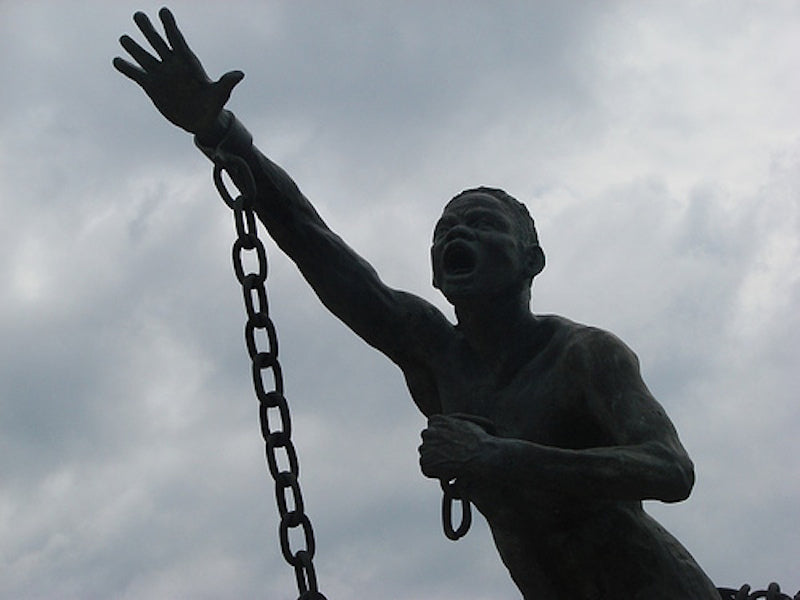
To celebrate the publication of Futures of Black Radicalism, edited by Gaye Theresa Johnson and Alex Lubin, we have 40% off our Race and Ethnicity reading list until Sunday, September 3 at 11:59 PST.
Futures of Black Radicalism, edited by Gaye Theresa Johnson and Alex Lubin, brings together 17 essays on the development of the black radical tradition, all informed by both the groundbreaking work of Cedric J. Robinson and the contemporary flourishing of black political movements.
First published in Race & Class, this 1981 essay by Cedric Robinson rehearses some of themes he would go on to develop in Black Marxism.
The masses in history
Let me begin by asking your consideration of an extraordinary declaration, one which I believe will stand us in good stead as we review, as we explore the dynamic development of black peoples in the nineteenth century. I am beginning in this way because I believe the most important issue is conceptualisation: how are we to conceptualise what we were, what we are, what we are becoming? The task is to achieve a means of conceptualising change, Specifically the developments among black peoples which constituted their response to the incorporation of their labour and lives into the emerging system of world capitalism in the nineteenth century. For this particular period, the nineteenth century, and because of the structural, material, and ideological systems and the organisational imperatives within which the black reaction took form, a specific methodological instruction is warranted; a way of comprehending the movements of slaves in the Caribbean, North America, and the Iberian colonies of central and south America, and the resistance movements on the African continent. The declaration is by C.L.R. James, it was written in 1948 or so, and concerns the formation of social forces in general, though it was originally addressed quite directly to James' colleagues in the Fourth International. In Notes on Dialectics (which I believe is published this year for the first time), James observed:
Now what is one to say of a political organisation that goes to the people with the proposal to organise a body of professional revolutionaries, in the Leninist manner of 1903?...
What do such 1903 revolutionaries of 1948 propose to organise? A new international or genuine revolutionaries?... There is nothing more to organise. You can organise workers as workers. You can create a special organisation of revolutionary workers. But once you have those two you have reached an end. Organisation as we have known it is at an end. The task is to abolish organisation. The task today is to call for, to teach, to illustrate, to develop spontaneity — the free creative activity of the proletariat. The proletariat will find its method of proletarian organisation. 1
For many years James was associated with a sense of revolutionary theory and revolutionary organisation which has been identified with spontaneity. Within the understanding of spontaneity there is a basic kind of revolutionary thought which I want to use essentially as a premise for the study of black liberation and its development in the nineteenth century. James, it might be added, was not alone with his spontaneity. The period during which he was writing spawned others. Spontaneity had been looked at, thought about, thought through by other people. Indeed, I want to quote a small section from Wilhelm Reich's The Mass Psychology of Fascism to give you a sense of spontaneity. Reich wrote — and he was writing in the mid 1940s:
Usually an important social awareness begins to assume a more or less clear form among the population long before it is expressed and represented in an organised way. Today, 1944, the hatred of politics, a hatred based on concrete facts, has undoubtedly become general. If, now, a group of social scientists has made correct observations and formulations, that is, observations and formulations that clearly reflect the objective social processes, then the “theory" must of necessity be in agreement with the vital feelings of the masses of people. It is as if two independent processes moved in a convergent direction and came together at one point at which the social process and the will of the masses became one with sociological knowledge. 2
That is one of the premises of spontaneity. The basic argument and belief is that organisation and ideas come out not from the leadership but from the masses. Organisation and ideas. Now, this is essentially the position of people like James and Reich, who argued that it is inappropriate for an elite to emerge with a sense of what organisations are required, what structures are required and then begin to influence or to impose this notion on a following, on a collectivity. It was a sense of human history and human organisation which is extraordinarily opposed to the ways in which we normally think of these things. The dominant paradigms of political organisation, social organisation, social movements presume the extraordinary leader, the extraordinary figure, out of which come organisations, structure, ideology. James and Reich were reversing them. 3 I believe it is important to keep this perception in mind while we review the dialectic of imperialism and the culture of liberation. It is a key to black mass movements formed in communities and societies within which class formation was tenuous if not wholly absent.
The Negro in western thought
In the 500 years which have led directly to this moment, the destinies of African peoples have been profoundly affected by the development of economic structures and political institutions among European peoples. Moreover, it has been the nature of these relationships between Africans and Europeans that both western civilisation and the cultures of African peoples have been increasingly contorted and perverted as the years have accumulated. For the West, the appropriation of the means and forces of African reproduction have had unintended and unacceptable significance. The psychic, intellectual, and cultural consequences of Europe's intrusion into African history have served to accelerate the formulation of the mechanisms of self-destruction inherent in western civilisation, exacerbating its native racisms, compelling further its imperatives for power and totalitarian force, while subverting the possibilities of the rationalisation of its states, its diverse cultural particularities, and its classes. Everywhere one turns or cares to look, the signs of a collapsing world are evident; at the centre, at its extremities, the systems of western power are fragmenting. Thus the British empire at the beginning of the twentieth century, the German empire in the middle years of this century, and the American empire today are simultaneously forewarnings, witnesses and the history of this dissolution; and the development of each testified to the characteristic tendency of capitalist societies to amass violence for domination and exploitation and a diminishing return, a dialectic, in its use. "Things fall apart; the centre cannot hold..."
My subject, however, is not primarily the modern western world and its contortions, so my remarks on the West will tend to remain general and descriptive rather than detailed and analytic. I intend to focus on the nineteenth century, the century of the modern world's adolescence, and on the formation and emergence of African peoples.
Before the African and New World black liberation movements of the post-Second World War era, few western scholars of the African experience had any conception of the existence of an ideologically based or epistemologically coherent historical tradition of black radicalism. The presence of such a tradition, the possibilities and conditions of its existence were literally and configuratively alien to these observers. Given the presumptions these students of Africa and its diaspora made about the bases of the identities, cultures, ethnicities and group formations of these various African peoples, neither space nor time, geography or periodicity, led them to suspect the presence of such a tradition. In its stead, these observers reconstructed social and ideological movements among blacks to conform to the exigencies of specific locales and of immediate social causes. If in their minds such movements sometimes were allowed some resemblance to one another, this followed from the fact of a general racial order shared by most blacks, whether as slaves or ex-slaves, rather than the presence of an historical or political consciousness or a social tradition among blacks. An ideological connective was presumed remote between the African mutineers on the Amistad or the captors of the Diane; the Maroon settlements in Pernambuco, Florida, Virginia, Jamaica and the Carolinas; the slave revolutionists of the Revolution in Haiti; the slave insurrectionists of the Caribbean and early nineteenth-century America; the black rebels of the regions of the Great Fish river, the Limpopo and the Zambezi in southern Africa; the black emigrationists of the American ante-bellum period; the untolled wars across the African landscape in the 1900s; and their twentieth-century successors in Africa and the diaspora. These events were seen as geographically and historically bounded acts, episodes connected categorically by the similarity of their sociological elements (e.g. slave or colonial societies) but evidently unrelated in the sense of an emerging social movement inspired by historical experience and a social ideology. Such scholarship, of course, was either inspired or at least influenced by the ideological requirement that modern western thought obliterate the African. As an ideological current, its adherents were not always Europeans. It permeated the intellectual culture and even compromised the work of some of those Africans' descendants.
There is little which is novel in the remark that in the New World and in the colonial clusters in the African continent and the Indian and Atlantic Oceans the African became the most enduring of domestic enemies, and consequently the object around which a more specific, particular and exclusive conception of humanity was moulded. As a slave, the African was the embodiment of a moral, political, and economic contradiction demanding resolution. Of all the neologisms put into use, the term "Negro" proved the most enduring. The "Negro," that is the colour black, was both a negation of African and a unity of opposition to white. The construct of Negro, unlike the older terms African, Moor, or Ethiope, suggested no situatedness in time, that is history, or space, that is ethno- or politico-geography. The Negro had no civilisation, no cultures, no religions, no history, no place and, finally, no humanity which might command consideration. The Negro constituted a marginally human group, a collection of Things of convenience for use and/or eradication. Obviously, no historical political tradition could be associated with such beings. This was the point when the Harvard historian Justin Winsor told a young black scholar a century ago that he, that is Winsor, had never considered the Negro as a "historical character"; it was also the heart of the matter when Hugh Trevor-Roper announced in 1963: "Perhaps, in the future, there will be some African history to teach. But at the present there is none: there is only the history of the Europeans in Africa. The rest is darkness..."
Thus it came about that one of the first responsibilities of the black intelligentsia was to destroy the Negro. This was the precondition for the reassertion of the historical tradition of African peoples — the attack on culture with a specific political significance.
I think one of the most extraordinary statements on this question, and probably one of the most frequently misunderstood, is an essay that Karl Marx wrote in 1843, called "On the Jewish Question." Much of what he discovered about western consciousness and the Jew is applicable to the Negro. Marx has been interpreted to say that it was important and necessary for human emancipation that the Jews be destroyed. It is written in some fashion in that essay but I do not believe that is what Marx at any time meant to say. He was involved in the first attack, the attack on culture. The attack on culture assumed the form of an attack on conceptualisations, or an attack on ideas, or an attack on the meanings of things. Marx understood that in early nineteenth-century German Society it was not possible for the masses of Germans to understand the Jews. He also presumed it was not necessary for them to understand the Jews. And so he used the term Jew to signify precisely its opposite; he used the term Jew to talk about the non-Jew. And in that process he began to reverse, he began to transform, he began to attack the culture which was associated with, linked to, and a support of the oppression that he as a Jew knew and that non-Jews would have to come to some sense of in Germany. He developed his argument in a fairly simple way:
Let us consider the real Jew, not the Sabbath Jew, whom Bruno Bauer [the man he was addressing in his essay] considers, but the every day Jew. Let us not seek the secret of the Jew in his religion but let us seek the religion in the real Jew. What is the profane base of Judaism: practical needs, self-interest. What is the worldly cult of the Jew: huckstering. What is his worldly god: money. 5
Then he writes:
Judaism has been preserved, not in spite of history, but by history. It is from its own entrails that civil society ceaselessly engenders the Jew. What was, in itself, the basis of the Jewish religion? Practical need, egoism. 6
There is only one way in which we can begin to understand what he was saying, what he was dealing with. He was confronting that part of the culture — the German culture and Jewish culture — which argued that the Jew was significant because of selection, because of a peculiar culture, because of a peculiar national identity. Marx was denying it. He said, it was not the Jews who had made themselves, but society which required the Jews, which allowed the Jews to maintain themselves. He was arguing that the culture had conceptualised a people and a process in the wrong way, in an absurd way, in an irrational way, ultimately, in a very destructive way. As we can see, Marx was not entirely consistent with his distinction between the religious Jew (the historical Jew) and the western arte-factual Jew (the actual Jew). Still, even his slips did not obscure his intent.
He went on to say, in fact, that Judaism was the ideology of civil society, not of Jews. He was arguing, in fact, that the Jew had become the symbol of the society, a symbol that it could not deal with directly, and so had to project on to some thing, which it then had — in Marx's term — to alienate from itself. The society had developed a symbol for itself, but outside of itself. And it called that symbol the Jew. Marx was saying, it is no longer possible to understand German society unless you recognise it in the Jew, in its Jew.
The first attack is an attack on culture. Marx refused to accept the terms, the language, the conceptualisations of the society which he was addressing. He could not accept them because he understood them to be distortions, very pointed, very clearly related to the oppression of a people. Black scholars of the nineteenth and twentieth centuries eventually came to a similar insight at a similar moment. But remember the premise, I am not necessarily saying that this was Marx's idea: Marx organised the idea. In the same fashion, black intellectuals organised their ideas on their radical tradition.
Black thought and the traditions of the West
The difference for these ideologues was not one of interpretation but comprehension. The makings of an essentially African response, strewn across the physical and temporal terrain of societies conceived in western civilisation, has been too infrequently distinguished. Only over time has the setting for these events been integrated into the tradition. The social cauldron of black radicalism is western society. Western society, however, has been its location and its objective condition but not — except in a most perverse fashion — its specific inspiration. Black radicalism is a negation of western civilisation, but not in the direct sense of a simple dialectical negation.
It is certain that the evolving tradition of black radicalism owes its peculiar moment to the historical interdiction of African life by European agents. In this sense, the African experience of the past five centuries is simply one element in the mesh of European history: some of the objective requirements for Europe's industrial development were met by the physical and mental exploitation of Asian, African, and native American peoples. This experience, though, was merely the condition for black radicalism — its immediate reason for and object of being — but not the foundation for its nature or character. Black radicalism, consequently, cannot be understood within the particular context of its genesis. It is not a variant of western radicalism whose proponents happen to be black. Rather, it is a specifically African response to an oppression emergent from the immediate determinants of European development in the modern era and framed by orders of human exploitation woven into the interstices of European social life from the inception of western civilisation. Walter Rodney understood this so well when he wrote:
...the similarity of African survivals in the New World points not to tribal peculiarities but to the essential oneness of African culture. That culture was the shield which frustrated the efforts of Europeans to dehumanise Africans through servitude. The slave may have appeared in a profit and loss account as an "item," a “thing," a piece of "property," but he faced his new situation as an African, a worker, and a man. At this level of perception, it is quite irrelevant to enquire from which tribe or region a particular African originated. 7
As we have seen in slave society and post-slave society, such a signification of African culture was accessible for practical and ideological reasons only in a most grotesque form, that is racism.
African labour as capital
Tracing the genesis of this conception among black intellects requires coming to terms with the development of capitalism as it related to black peoples. Necessarily, this requires a consideration of the African slave trade and slave labour, and the forms of forced labour and contractual labour which followed in both the historical and structural senses in the old and new worlds and on the African continent itself. 8 The scale of the importance of black labour to the formation of capitalist society can in part be measured in numbers. Philip Curtin has estimated that approximately ten million African workers were transported to the New World between 1451 and 1870. 9 Even more instructive, however, is his observation that before the nineteenth century "... for 300 years more Africans than Europeans crossed the Atlantic each year." 10 Marx, on the other hand, without Curtin's historical advantage, attempted to understand the structural relation of African labour to the development of capitalism. In the mid-nineteenth century, with the process stili unfolding, he wrote to Annenkov:
Direct slavery is as much the pivot of our industrialism today as machinery, credit, etc. Without slavery no cotton; without cotton no modern industry. Slavery has given value to the colonies; the colonies have created world trade; world trade is the necessary condition of large-scale machine industry ... Slavery is therefore an economic category of the highest importance. 11
And a few years later, in a slightly more agitated voice, he concluded:
The discovery of gold and silver in America, the extirpation, enslavement and entombment in mines of the aboriginal population, the beginning of the conquest and looting of the East Indies, the turning of Africa into a warren for the commercial hunting of black Skins, signalised the rosy dawn of the era of capitalist production. These idyllic proceedings are the chief momenta of primitive accumulation. 12
First, African workers were transmuted by the perverted canons of mercantile capitalism into property; then, African labour power as slave labour was integrated into the organic composition of nineteenth-century manufacturing and industrial capitalism, sustaining the emergence of an extra-European world market within which the accumulation of capital was garnered for the further development of industrial production.
In the New World, following the models provided by the Portuguese, the Spanish, and the Dutch, the British (and the French) had substantially substituted human capital for commodities. I will follow the British trade since, for a variety of reasons, it is possible to be more precise about its dimensions.
To be sure, the British had begun by exporting those colonised peoples to whom they had immediate access, that is the Irish. In the eighteenth century, for example, perhaps as many as 10,000 men, women, and children were "transported" from Ireland to the New World as so-called convicts. 13 There they joined the numbers of poor Englishmen drawn from a growing reservoir in England of which Edmund Morgan would comment: "In the eyes of unpoor Englishmen the poor bore many of the marks of an alien race." 14 As Richard B. Moore has indicated:
Somewhat less onerous [than African slavery], but still quite oppressive, was the system of indentured slavery of Europeans, forced in one way or another into the colonies whether on the mainland or in the islands. Writing of this, the Jesuit priest, Joseph J. Williams, relates how Irish peasants were "hunted down as men hunt down game, and were forcibly put on board ship, and sold to the planters of Barbadoes." 15
Nevertheless, the appetite of colonial production for labour increasingly outpaced the supply. Having decimated those aboriginal populations they had encountered in the New World, the English mercantile and planter bourgeoisie found it necessary and expedient to expand their Irish strategy to West Africa. And as they did so, the scale of their enterprise grew beyond anything seen in human history.
In the last twelve years of the seventeenth century, the legal importation of African labourers to British colonies in the Indies and North America reached almost 8,000 per year. 16 The illegal trade during the same period has been estimated to be a quarter of this size. Curtin, whose figures are certainly most conservative, calculates that the total import of African workers between 1690 and 1700 was close to 76,500. Since the loss in transit was about 23 per cent, this meant that in this eleven-year period, more than 99,000 Africans were embarked onto the Atlantic on their way to slave labour. By the end of the eighteenth century and the abolition of the legal British slave trade in 1807, those first 99,000 Africans had been augmented to 2,579,400. 17 Perhaps as many as 400,000 of them, however, never saw the end of the Atlantic in the West. They died "in transit." Such was one tragic meter of the profound extent to which the development of the capitalist world system depended on labour it could not produce itself. One other measure, this of the national and racial sympathies of the European merchants of slaves themselves, is that their crews died at even higher rates. An English sailor's song put it simply: "Beware and take care of the Bight of Benin: for one that comes out, there are forty go in." 18
Thirty-eight per cent of the slave labour force transported by English shippers was relocated to Jamaica. In almost equal parts, their origins had been along the routes which fed into the slave ports at the Bight of Biafra, the Gold Coast, Central Africa, the Bight of Benin, and Sierra Leone. 19 This ethnic distribution, however, was not the result of consistent or persisting patterns of recruitment. Orlando Patterson concludes, for example, that:
... during the earlier half of the period between 1655 and 1700 the largest single group of slaves came from among the Akan and Ga-Andangme peoples of the coastal strip of Ghana... Forty per cent of the slaves entering the island during the last quarter of the seventeenth century came from Angola... About 30 per cent of these later arrivals came from among the Ewe speaking people of Dahomey, particularly from among the Fon.
... between 1700 and 1730 there was a rapid falling off of the number of slaves coming from Angola while the number from the Slave Coast greatly increased to the position of being, quite possibly, the largest single contributor.
... The slaves from Ghana had also increased proportionately and may well have been the second largest section of the African slaves in the island ...
During the first half or so of the period between 1730 and 1790 there was a rapid falling off of slaves from the Slave Coast and a proportionate increase in those from Ghana and the Niger and Cross deltas. Between them they supplied about 70 per cent of the African slaves entering the island ...
Finally, during the last seventeen years of the trade there was a striking reappearance of slaves from Southwestern Africa, particularly from the region of the Congo. In all, about 40 per cent of all the slaves entering the island during this period came from this area; about 30 per cent from the Niger and Cross deltas; about 20 per cent from the Gold Coast; another 5 per cent from the Windward Coast; and the remainder from the other areas of Africa. 20
In many ways this Jamaican trade followed the patterns established by the mercantile European predecessors of the English. They, too, had deposited the majority of their African labour in the islands of the Greater and Lesser Antilles. The Portuguese with their Brazilian territories had been the exception — an exception which accounted for approximately 38 per cent of the total number of African peoples brought to the New World. 21
The British merchants sent approximately 20 per cent of their slave cargo in the eighteenth century to the North American colonies. However, this amounted to less than 5 per cent of the total number of Africans brought to the New World by European merchants. Curtin's best estimate is that 399,000 Africans were brought to the English colonies during the entire slave trading period (and another 28,000 came to Louisiana by way of French traders.) This African population, however, differed from that distributed in Jamaica in that at least a quarter of these peoples had been shipped from Angolan ports. Almost as many came from the Bight of Biafra, the Gold Coast and Senegambia, with decreasing numbers from Sierra Leone, the Bight of Benin, and Central Africa. 22 In South Carolina, blacks made up 60 per cent of the colony's population in the eighteenth century. In Virginia, the comparable figure was 40 per cent. They were used on the tobacco and, later, the cotton plantations, but they also worked "in mines, salt- and rope-works; and they trained as shipwrights, blacksmiths, and as various kinds of woodworkers, including carpenters, coopers, wheelwrights, and sawyers." 23 Those who were imported from Africa directly were termed "outlandish," to distinguish them from the "new Negroes" of the fields and the deracinated, acculturated artisan slaves. These distinctions were practical considerations for the colonists, as Gerald Mullin has demonstrated:
In sample runs of the South Carolina Gazette in the early 1750s and 1771 there was clear evidence of tribal cooperation in advertisements for the return of four "new Gambia men"; three Angolans, "all short fellows"; six other Angolans ... and four men from the "Fullah Country." 24
It was from the efforts of men and women such as these that the black settlements of Virginia's piedmont and the maroon peoples of the Caribbean and South America and among the Seminoles of Florida would be formed. Another estimated 55,000 fled to the British forces and loyalist settlements when the colonists pursued the fear of their own enslavement to the point of Revolution. 25 However, enough of the slaves remained in the colonies of North America and the Indies to play a significant role in the development of the English imperial economy. Eric Williams argued:
The triangular trade... gave a triple stimulus to British industry. The Negroes were purchased with British manufactures; transported to the plantations, they produced sugar, cotton, indigo, molasses, and other tropical products, the processing of which created new industries in England; while the maintenance of the Negroes and their owners on the plantations provided another market for British industry, New England agriculture, and the Newfoundland fisheries. By 1750 there was hardly a trading or a manufacturing town in England which was not in some way connected with the triangular or direct colonial trade. The profits obtained provided one of the main streams of that accumulation of capita in England which financed the Industrial Revolution. 26
This trade, this movement of black workers, did not, however, end with slavery's legal termination. Leopold's Congo, Harry Johnston's Central Africa, Cecil Rhodes' Southern Africa, Lugard’s West Africa, Portuguese and French Africa, as well as the New World's slave descendants, all contributed to the further development of the capitalist world system. As peasants, as tenant farmers, as migrant labourers, as day abourers, domestic servants and wage labourers, their expropriation extended into the present century. Even in the destruction of the means of production, the wars which Marx had stipulated as inevitable, black labour was pressed into service. They were exempt from no aspect of exploitation.
The imprint of the black historical tradition
Here, then, are the crude outlines of a trade and system of production which brought to the distant hemisphere a portion of the evolving people who would forge a black radical tradition. In that hemisphere, they began in the sixteenth century.
In Mexico, or New Spain as it was called, the native population is thought by some to have been as high as twenty-five million at the beginning of the sixteenth century. However, it was to become an object of the most intensive exploitation by its Spanish conquerors. Within nine decades, "diseases, wars, relocations, and the ecological changes wrought by Spanish settlement and control" and, it should be added, slave labour, had reduced the indigenous inhabitants to an estimated 1,075,000. 27 This decimation of the Indian population, coupled with the royal decrees of 1542 (the Nuevas Leyes) which "prohibited the further enslavement of Indians except as punishment for rebellion against Spanish rule," resulted in a significant demand for additional labour towards the end of the sixteenth century. 28 The new source of labour was to be the west coast of Africa. David Davidson surmises: "It is now fairly certain that in the period 1519-1650 the area received at least 120,000 slaves, or two-thirds of all the Africans imported into the Spanish possessions in America." 29 The industries of sugar and cloth production, and later of silver mining, were the primary sites to which African labour was assigned. As Indian labour atrophied during the second half of the century, a consequence of natural decline and legal restrictions, it was replaced by African workers. 30 By 1570, Mexico contained over 20,000 Africans; by 1650, their numbers were believed to be closer to 35,000, a supplement to the more than 100,000 Afronestizoes of black-Indian parentage. 31 By the latter period, Davidson states, between 8,000 and 10,000 Africans could be found working on the sugar plantations and cattle ranches in the eastern region around the coastal lowlands between Veracruz and Panuco and the slopes of the Sierra Madre Oriental; another 15,000 were absorbed by the silver mines and ranches of the regions north and west of Mexico City; 3,000-5,000 were bound to similar industries located between Puebla and the Pacific coast; and 20,000-50,000 were employed in urban occupations in Mexico City and the Valley of Mexico.
At first, resistance among the slaves took the form of flight to native or "Indian" settlements. The notarial archive, for example, of the Mexican city of Puebla de los Angeles, which is "virtually complete from 1540 on," is filled with the official reaction to mid-sixteenth-century runaways. 32 Fugitives drew the attention of Hernan Cortes as early as 1523, and the first general uprising is thought to have occurred in 1537. 33 Some of these Africans, however, did not completely sever their contacts with the Spanish. Once freed by their own wits, they returned to plague the Spanish colonists, appropriating food, clothes, arms, tools and even religious artefacts from the colonists' towns, villages, and ranch homes and from travellers along the roads connecting the ports and settlements. Once armed, the Spanish would refer to these "fugitives" as cimarrones. 34 (The English would incorporate the term into their own language as "maroons.") Soon, however, the fugitive slaves grew numerous enough to begin the formation of their own settlements, communities which came to be known in Mexico as palenques.
By the 1560s fugitive slaves from the mines of the north were terrorising the regions from Guadalajara to Zacatecas, allying with the Indians and raiding ranches. In one case maroons from the mines of Guanajuato joined with unpacified Chichimec Indians in a brutal war with the settlers. The viceroy was informed that they were attacking travellers, burning ranches, and committing similar "misdeeds." To the east, slaves from the Pachuca mines took refuge in an inaccessible cave from which they sallied forth periodically to harass the countryside. Negroes from the Atotonilco and Tonavista mines joined them with arms, and created an impregnable palenque. 35
The response of the representatives of the Spanish state was unequivocal. Between 1571 and 1574, royal decrees detailed new systems of control and Surveillance, stipulating progressively harsher treatment of fugitives: fifty lashes for four days' absence; 100 lashes and iron fetters for more than eight days' absence; and death for those missing for six months, commuted in some cases to castration.
Yet neither the code of 1571-1574 nor the issuance of restrictive legislation in the 1570s and 1580s was of any avail. A viceregal order of 1579 revealed that the contagion of revolt nearly covered the entire settled area of the colony outside of Mexico City, in particular the provinces of Veracruz and Pánuco, the area between Oaxaca and Gualtuco on the Pacific coast, and almost the whole of the Gran Chichimeca. Only emergency repressive measures and the continued importation of Africans maintained Mexico's slave labour supply. 36
African resistance in Mexico continued to mature in form and character. The struggle against slavery was being transferred into the battle to preserve the collective identity of African peoples. By the early seventeenth century, according to official colonial documents, at least one black community, San Lorenzo de los Negros, had acquired by war and treaty its right to existence. In the mountains near Mt Orizaba, led by a man called Yanga, whose origins were among the Bran nation of the Senegambia region, the "Yanguicos" had won formal status as a free black settlement. The mountains, however, seemed to promise much more security to some Yanguicos and other cimarrones than the words and treaties of their Spanish oppressors. Throughout New Spain palenques continued to multiply and, with a still undetermined frequency, to give occasion for the establishment of officially recognised free communities. Between 1630 and 1635, for example, an agreement was reached with cimarrones whose redoubts had been established in the mountains of Totula, Palmilla, Tumbacarretas, and Totolinga near Veracruz. The town of San Lorenzo Cerralvo became their free settlement. In 1769, a similar history preceded the establishment of Nuestra Señora de Guadalupe de los Morenos de Amapa, near the southern tip of the modern state of Veracruz. 37 Their existence has come to light through quite recent research into the early colonial history of New Spain. It is always possible that these few villages were the only instance of such occurrences, but not very probable. 38 It is more likely that further research will identify their familiars, traced perhaps through work among the black communities of present-day Mexico. 39 In Colombia, their revolts are detailed in 1530, 1548, and again in the 1550s. In 1552, Venezuela had its first major slave revolt. This rebellion of slaves who had worked in the mines of Buria was defeated in 1555. Nevertheless, by the beginning of the seventeenth century, independent black communities with legal standing in the eyes of the state agents had begun to appear. 40
In Brazil, which dominated the Portuguese slave trade, the maroon settlements (quilombos) which began in the sixteenth century would extend into the next. Ernesto Ennes, in no way sympathetic to the fugitives, nevertheless recorded in 1948 from his review of the documents in the Arquivo Histórico Colonial in Lisbon that he found "traces in every corner of Brazil" of quilombos. 41 In the Pernambuco region, the greatest settlement of all, the extraordinary state of Palmares endured from 1605 to 1695.
Palmares (the name stood for the several settlements (palmars) which made up a community), though necessarily agrarian, was even more preoccupied with its defence. In 1645, Bartholomeus Lintz, acting as a scout for the expeditions which the Dutch were to mount against Palmares, was the first hostile European to discover that the state consisted of several settlements (two major palmars of 5,000 inhabitants, and several small units totalling 6,000). By 1677, there were ten major palmars, one of which was the capital (Macoco) where the "king" (Ganga-Zumba, from the Zande, signifying consensus ruler) resided, the whole state spanning over sixty leagues. 42 It was then estimated that the population numbered between 15,000 and 20,000, a mixture of creoles and Africans largely drawn from the Angola-Congo regions. For almost a century, neither the Portuguese nor the interloper Dutch, nor the creole moradores could destroy it. "Between 1672-94," R.K. Kent tells us, "it withstood on the average one Portuguese expedition every fifteen months." 43 Palmares did fall eventually, in 1694, the result of campaigns launched by successive Portuguese governors of Pernambuco (João da Cunha Sotto-Mayor, Marques de Montebello, and Melo de Castro). The last expedition sent against it consisted of nearly 3,000 men and was in the field for several months. The final siege started on 10 November 1693 and lasted until early February of the following year. The total cost of the adventure was estimated by Melo de Castro at somewhere near 1,400,000 cruzados. 44
On the night of 5 February 1694, "Zumby" (Ganga-Zumba), who organised the defence of Palmares, having discovered that his position on Barriga mountain had been nearly encircled, sought a last desperate chance to escape. The result was described by Colonel Domingos Jorge Velho, the leader of the Portuguese forces:
During the second watch of that night, between the fifth and sixth of February, suddenly and tumultuously [Zumby] with all his people and the equipment which could follow him through that space, made an exit. The sentinels of that post did not perceive them almost until the end. In the rear-guard Zumby himself was leaving, and at that point he was shot twice. As it was dark, and all this was taking place at the edge of the cliff, many — a matter of about two hundred — fell down the cliff. As many others were killed. Of both sexes and all ages, five hundred and nineteen were taken prisoner. 45
In Pernambuco, again according to Governor Melo de Castro, "This happy victory was regarded as no less important than the expulsion of the Dutch. It was, accordingly, celebrated by the whole population with displays of lights for six days and many other demonstrations of joy, without any command being given to them..." Characteristically, Ennes attributed this excitement to the "moral influence which it conferred on the authorities." 46
In this same century, the slaves of Jamaica joined the tradition of those in Brazil and Mexico (where important revolts occurred in 1608 and 1670). The mid-century exploded with revolts on that island in 1669, 1672 (twice), 1678, 1682, 1685, and 1690. Barbara Kopytoff has described it most aptly:
During the era of slavery, communities of maroons, or escaped slaves, sprang up throughout the New World. Wherever there were slave plantations, there was resistance in the form of runaways and slave revolts; and wherever mountains, swamps, or forests permitted the escaped slaves to gather, they formed communities. These ranged in size from Palmares, in Brazil, with over ten thousand people, to the handfuls of runaways who hid on the fringes of plantations in the American South. While most ... were destroyed ... a few could not be reduced or even contained... 47
And so the litany continued into the eighteenth century: in the Guianas of Berbice, Essequibo, and Demerara in the 1730s and 1760s; in Venezuela in the 1730s and 1780s. In North America, the maroon communities of the mid-century in Florida, Virginia and the Carolinas were anticipated by the slave revolt in New York city in 1712 and that of Stono, South Carolina, in 1739. Gerald Mullin found in Virginia newspapers alone advertisements for nearly 1,300 fugitives from slavery between 1730 and 1800. 48
The eighteenth century ended with a movement of slaves to match the significance of Palmares during the preceding century. In Haiti, slave armies managed the defeat of French, Spanish and English militaries — the most sophisticated armies of the day. James summed up his reconstruction of that revolution of slaves:
No one could have guessed the power that was born in them when Boukman gave the signal for revolt on that stormy August night in 1791. Rebellion, war, peace, economic organisation, international diplomacy, administration, they had shown their capacity ... The national struggle against Bonaparte in Spain, the burning of Moscow by the Russians that fill the histories of the period, were anticipated and excelled by the blacks and Mulattoes of the island of San Domingo. The records are there. For self-sacrifice and heroism, the men, women and children who drove out the French stand second to no fighters for independence in any place or time. And the reason was simple. They had seen at last that without independence they could not maintain their liberty... 49
From Haiti, the revolution extended to Louisiana in 1795, Virginia in 1800 and Louisiana again in 1811. Quite recently, Eugene Genovese has remarked:
Gabriel Prosser in 1800 and Denmark Vesey in 1822 consciously looked to Haiti for inspiration and support, and as late as 1840 slaves in South Carolina were interpreting news from Haiti as a harbinger of their own liberation ... The slaveholders ... understood the potential of what they saw. References to the example and inspiration of Haiti reverberated across black America. The impact on David Walker may be readily seen from his great Appeal... And the slaveholders were not amused by celebrations of Haitian independence such as that staged in 1859 by free Negro masons in St. Louis, Missouri — a slave state ... The revolution in Saint-Domingue propelled a revolution in black consciousness throughout the New World. 50
From Haiti and the "one great militia," which DuBois and Genovese claim the white South constituted, the revolutionary tradition lit up the horizon of Brazil's Bahia region. 51 From 1807 to 1835, the chroniclers of Bahia recorded revolt after revolt: 1807, 1809, 1813, 1816, 1826, 1827, 1830 and the great series in 1835. Jamaica and the Guianas continued in the tradition, culminating in the Great Revolt in Jamaica in 1831. By 1838, slavery in Jamaica had been officially dismantled. As Mary Reckord has put it: "The slaves had demonstrated to some at least of those in authority that it could prove more dangerous and expensive to maintain the old system than to abolish it." 52 Similar moments arrived in the United States in 1863 and Brazil twenty-five years later. 53
In Africa itself, the same historical tradition was no less apparent in the nineteenth century. But we must also keep in mind the warning issued by George Padmore and C.L.R. James that it was the colonial habit not to maintain a very close record of these events:
The difficulty ... is to get accounts written in any detail. The British send out their punitive expeditions against revolting tribes and do not necessarily mention them in the annual colonial reports. But if the revolt awakens public interest, a commission will investigate and make a report. This report will frequently clash violently with the accounts of participants, eye-witnesses, correspondents of newspapers, native and European, and persons living in the colony at the time. The French and Belgians, however, publish little of this kind... 54
The European presence in Africa at the beginning of the century had been largely confined to a few settlements in southern Africa and to trading posts and factors on the northern, western, and eastern coasts. Even by the 1850s, James and Padmore assert, "it is unlikely that more than one tenth of Africa was in European hands." 55 Nevertheless, the century had opened with resistance. In southern Africa, the Xhosas' Hundred Years War (1779-1880) with the white colonists was already into its third decade. Before its obviously impermanent conclusion, it would take this people as deeply into the historical tradition as any black people, even the Haitians, had dared. The Nongquase or "cattle-killing" of 1856-7, which resulted in the deaths of tens of thousands of Xhosas by self-inflicted starvation, continues to evade western comprehension. 56 The Zulu also came to the point of military resistance. From the emergence of the Zulu state in the early decades of the century to the wars of the 1870s and 1880s, the Zulus fought the disruption of the material and spiritual being. Eight thousand Zulu fell in battle in 1879 alone, the same year that the assegais defeated the gun in the terrible encounter at Isandhlwana. As the century progressed, the European intrusion became more marked and resistances more numerous.
In Angola, the Portuguese fought wars of pacification in the 1850s and the 1880s. In what is now Tanzania, the Yao and Hehe in the 1890s confronted the Germans who transgressed the bounds of good manners. Machemba, the Yao general, had written to them in Swahili: "If it should be friendship that you desire, then I am ready for it, today and always; but to be your subject, that I cannot be." 57 In the 1870s the Ashanti began their wars with the British; in the 1890s the Mendi of Sierra Leone did the same. And in 1896, as a complement to the achievement of the Haitian slaves 100 years earlier, Menelik II of Ethiopia mounted an army of 100,000 in order to defeat the Italian invader. There were, of course, many others: the Yoruba of West Africa, the Baganda of East Africa, the peoples of the Atlas Mountains in the north, the Shona, Ndebele, Ndlambe and Ngqika of the south. Many of them had to wait a long time for their celebration, many are still waiting.
It was, though, the pattern, the construction, the evolving form which was and is most interesting. The historical integration which the slave trade had accomplished almost instantaneously in the New World was now occurring on the continent. Discrete societies were slowly achieving the social organisation which the attack on colonialism required. This achievement as a structural phenomenon was a concomitant of the world system and the imperialist expansion which it demanded. Its coherence, however, was based on the African identities of its peoples. As a structural process, its dynamics were seated in the very expansion of imperialism. This was the dialectic of imperialism and liberation, the contradiction which compelled the appearance of resistance and revolution out of the condition of oppression — even from its ideology. As Michael Taussig has written, with early colonial Colombia in mind:
The scanty accounts of Christianisation suggest that conversion and consolidation of belief remained little more than a formality throughout the entire epoch of slavery. Indeed ... the slaveowners regarded Christianised slaves as more rebellious and as poorer workers than those not indoctrinated, and would pay less for them. ... Black popular religion could hardly endorse slavery and all it inplied, nor could the slaves remain content with equality in God's eyes but not in their own. 58
The nature of the black radical tradition
This brings me finally to the character or, more accurately, to the ideological, philosophical, and epistemological natures of the black movement whose dialectical matrix was capitalist slavery and imperialism. What events have been most consistently present in its phenomenology? Which social processes has it persistently reiterated? From which social processes is it demonstrably, that is historically, alienated? How does it relate to the political order? Which ideographic constructs and semantic codes has it most often exhibited? Where have its metaphysical boundaries been most certainly fixed? What are its epistemological systems? These are the questions which we now must address, relieved from paradigmatic and categorical imperatives whose insistence stemmed largely from their uncritical application, the unquestioned presumption that regardless of their historical origins they were universal. Having arrived at an historical moment, at a conjuncture, at an auspicious time where the verities of intellectual and analytical imitation are no longer as significant to the black ideologue as they once were, where the dominant traditions of western thought have once again been revealed to have a casual rather than systemic or organic relationship to the myriad transformations of human development and history, when — and this is the central issue — the most formidable apparatuses of physical domination and control have disintegrated in the face of the most unlikely oppositions (India, Algeria, Vietnam, Guinea-Bissau, Iran, Mozambique), the total configuration of human experience requires other forms.
The first step is relatively easy because it was always there, always indicated, in the histories of the radical tradition. Again and again, in the reports, casual memoirs, official accounts, eye-witness observations and histories of each of the tradition's episodes, from the sixteenth century to the events recounted in last week's or last month's journals, one note has occurred and recurred: the absence of mass violence. 59 Western observers, often candid in their amazement, have repeatedly remarked that in the vast series of encounters between blacks and their oppressors, only some of which have been recounted above, blacks have seldom employed the level of violence which they (the westerners) understood the situation required. When we recall that in the New World of the nineteenth century the sixty or so whites killed in the Nat Turner insurrection was one of the largest totals for that century; when we recall that in the massive uprisings of slaves in 1831 in Jamaica — where 300,000 slaves lived under the domination of 30,000 whites — only fourteen white casualties were reported; when in revolt after revolt we compare the massive and often indiscriminate reprisals of the civilised master class (the employment of terror) to the scale of violence of the slaves (and presently their descendants), at least one impression is that a very different and shared order of things existed among these brutally violated people, Why did Nat Turner, admittedly a violent man, spare poor whites? Why did Toussaint escort his absent master's family to safety before joining the slave revolution? Why was "no white person killed in a slave rebellion in colonial Virginia"? 60 Why would Edmund Morgan and Gerald Mullin argue that slave brutality was directly related to acculturation, "that the more slaves came to resemble the indigent freemen whom they displaced, the more dangerous they became"? 61 In every century it was the same. The people with Chilembwe in 1915 force-marched European women and children to the safety of colonist.settlement. And, in that tradition, in the 1930s James ambivalently found Dessalines wanting for his transgressions of the tradition. Dessalines was a military genius, yes. He was shrewd, cunning, but he was also a man whose hatred had to be kept "in check." 62
There was violence, of course, but in this tradition it most often was turned inwards: the active against the passive, or, as was the case of the Nongquase of 1856, the community against its material aspect. This was not "savagery" as the gentlemen-soldiers of nineteenth- and twentieth-century European armies arrogantly reported to their belowed publics at home. Neither was it the "fratricide" of Fanon's extended Freudianism. And only seldom was it the devouring "revolutionary terror" of the "international bourgeois democratic revolution" which Genovese's neo-marxism has led him to acknowledge. 63 This violence was not inspired by an external object, it was not understood as a part of an attack on a system, or an engagement with an abstraction of oppressive structures and relations. Rather, it was their Jonestown, our Nongquase: the renunciation of actual being for historical being; the preservation of the ontological totality granted by a metaphysical system which had never allowed for property in either the physical, philosophical, temporal, legal, social, or psychic senses. For them defeat or victory was an internal affair. Like those in the 1950s who took to the mountains and forests of Kenya to become the Land and Freedom Army, the material or "objective" power of the enemy was irrelevant to their destinies. His machines which flung metal missiles, his vessels of smoke, gas, fire, disease, all were of lesser relevance than the integral totality of the people themselves. This was what Chilembwe meant when he entreated his people to "strike a blow and die." This is what all the Jakobos in all the thousands of Chishawashas and at all the tens of thousands of beer-parties which dot the black world have been saying for tens of generations: "We had only ourselves to blame for defeat." 64 This was a revolutionary consciousness which proceeded from the whole historical experience of black people and not merely from the social formations of capitalist slavery or the relations of production of colonialism.
Cabral, I believe, has made this point in the obverse when he asserted that "it is generally within the culture that we find the seed of opposition, which leads to the structuring and development of the liberation movement." 65 If he, and Morgan, and Mullin and Genovese (by sheer accident I assure you) are correct, then it is quite possible that massive black violence is largely an artefact of westernisation. I suspect that it would appear among those blacks most deeply implicated in the institutions and cultures of the West. Our soldier/presidents-for-life who mark the national landscapes of modern Africa would seem to confirm this. Our black intellectuals in power seem frequently to be just as pathological. At Oxford, at Harvard, at the Sorbonne and their satellites, they have ingested sets of rules with cataclysmic consequences. They knife though our lives making the choices of madmen and specialists.
In one sense, of course, they are the heirs of the nineteenth century. Still, their inheritance is the unnatural one. There is a more natural legacy in that century, one of which I hope I have given you some indication.
References
1. C.L.R. James, Notes on Dialectics (London, 1980), pp. 123-4.
2. Wilhelm Reich, The Mass Psychology of Fascism (New York, 1970), pp.211-12.
3. Of course, despite the dissimilarities in their backgrounds, both James and Reich were raising political objections to an international Communist movement dominated by Stalin's authorisation of "Marxist-Leninist" (Bolshevik) centralisation. In the early 1930s, James had opted for Trotsky over a Stalin resolute in the pursuit of "socialism in one country," the destruction of the revolutionary Bolshevik party and the abandonment of national liberation movements in the colonies of the "bourgeois-democracies" of Britain, France and Belgium. Reich, from his direct experience of workers' consciousness in the clinics he helped to organise in Vienna and Berlin in the late 1920s, expelled from the German Communist Party (and the International Psychoanalysis Association) in the early 1930s for his public criticisms of the Party's defaulting to the Nazi movement, was in his first stage of disaffection: the pursuit of "sexual politics.: See C. L. R. James, "Laski, St. Paul and Stalin," in The Future in the Present (Westport, 1977); Wilhelm Reich, "What is class consciousness," in Sex-Pol (New York, 1972).
4. Hugh Trevor-Roper, "The rise of Christian Europe I," in The Listener (28 November 1963), p. 871.
5. Karl Marx, “On the Jewish question,: in Robert Tucker (ed.), The Marx-Engels Reader (New York, 1972), p.48.
6. ibid., p.50.
7. Walter Rodney, "Upper Guinea and the significance of the origins of Africans enslaved in the New World," Journal of Negro History (Vol. LIV, no. 4, October 1969), p.345.
8. These are, obviously, pre-eminently economic indices and it is the convention of this particular tradition of inquiry to employ them as such, strictly, to divulge the nature of the relationship between blacks (labour) and capitalism (mode of production). Here, however, the intention is not a reductionist one but an attempt to demonstrate in the simplest terms.
9. Philip Curtin, The Atlantic Slave Trade (Madison, 1969), pp.265-9.
10. Philip Curtin, "The Atlantic slave trade, 1600-1800," in J.F.A. Ajya and Michael Crowder (eds), History of West Africa, Vol. I (New York, 1972), p.240.
11. Karl Marx, Letter to P.W. Annenkov, December 28, 1846, in The Poverty of Philosophy (New York, 1971), p. 188.
12. Karl Marx, Capital, Vol. 1 (New York, 1977), p. 751.
13. Abbot Smith, Colonists in Bondage (Williamsburg, 1947), p. 34.
14. Edmund Morgan, American Slavery, American Freedom (New York, 1975), pp.325-6.
15. Richard B. Moore, "On Barbadians and minding other people's business," New World Quarterly (Vol. III, nos. 1 & 2, Dead Season, 1966 and Croptime, 1967), p.69.
16. Curtin, The Atlantic Slave Trade, op. cit., p. 151.
17. ibid., pp. 15 1-4.
18. ibid., p.282.
19. ibid., pp. 139-40.
20. Orlando Patterson, The Sociology of Slavery (Kingston, 1969), pp. 142-4.
21. Curtin, The Atlantic Slave Trade, op. cit., pp.91-2.
22. ibid.
23. Gerald Mullin, Flight and Rebellion (New York, 1972), p.7.
24. ibid., p.43.
25. F. Nwabueze Okoye, "Chattel slavery as the nightmare of the American revolutionaries," William and Mary Quarterly (Vol. XXXVII, no. 1, January 1980), pp.3- 5; C.L.R. James, “The Atlantic slave trade," in The Future in the Present (Westport, 1977), p.246; Jeffrey Crow, "Slave rebelliousness and social conflict in North Carolina 1775-1802," William and Mary Quarterly (Vol. XXXVII, no. 1, January 1980), p.89.
26. Eric Williams, Capitalism and Slavery (New York, 1966), p.52.
27. David Davidson, "Negro slave control and resistance in colonial Mexico, 1519-1650," Hispanic American Historical Review (Vol. XLVI, no.3, August 1966), p.236.
28. Peter Boyd-Bowman, “Negro slaves in early colonial Mexico," The Americas (Vol. XXVI, no, 2, October 1969), p. 136.
29. Davidson, op. cit., p.236.
30. Antonio Vazquez de Espinosa, author of Compendium and Description of the West Indies (Washington DC, 1942), recounts some of the measures used by Spanish colonists to delay the loss of Indian labour to their enterprises: “...although the Royal Council of the Indies... has tried to remedy this evil with warrants and the amelioration of this great hardship and enslavement of the indians, and the Viceroy of New Spain appoints mill inspectors ... since most of those who set out on such commissions, aim rather at their own enrichment ... and since the mill owners pay them well, they leave the wretched Indians in the same slavery ... the mill owners keep places provided in the mills in which they hide the wretched Indians against their will, so that they do not see or find them, and the poor fellows cannot complain about their wrongs.” (p. 134)
31. Davidson, op. cit, p. 237.
32. Boyd-Bowman, op. cit., p. 134.
33. Leslie Rout Jr., The African Experience in Spanish America (Cambridge, Mass., 1977), p. 105; Davidson, op. cit., pp.242-3.
34. Rout, op. cit., p. 101.
35. Davidson, op. cit., p. 244.
36. Ibid., pp.245-6.
37. William Taylor, “The foundation of Nuestra Señora de Guadalupe de los Morenos de Amapa," The Americas (Vol. XXVI, no.4, April 1970), pp.441-6.
38. As an indication of how fleeting is certainty, Davidson in 1966 was willing to argue that San Lorenzo de los Negros had been the only such settlement: “Yanga's maroon movement is a notable incident in the history of Negroes in Mexico — the only known example of a fully successful attempt by slaves to secure their freedom en masse by revolt and negotiation and to have it sanctioned and guaranteed in law." (Davidson, op. cit., p.259) Only four years later, Taylor (op. cit.) had published his discovery of Nuestra Señora de Guadalupe de los Morenos de Amapa. And Vazquez de Espinosa, writing contemporaneously to the foundation of San Lorenzo, described a "village of free Negro and mulattoes" in the nearby district of Guatemala (op. cit., p.224).
39. Rout, op. cit., pp.278-82.
40. ibid., pp. 109, 111; Aquiles Escalante, “Palenques in Colombia”, in Richard Price (ed.), Maroon Societies (Garden City, 1973), pp.76-7; Miguel Acosta Saignes, "Life in a Venezuelan Cumbe', in Richard Price, op. cit., pp. 64-73.
41. Ernesto Ennes, “The Palmares 'republic' of Pernambuco: its final destruction, 1697", The Americas (Vol. V, no.2, October 1948), p.201.
42. R.K. Kent, “Palmares: an African state in Brazil," Journal of African History (Vol.VI, no.2, 1965), pp. 66-8.
43. ibid., p. 162.
44. Ennes, op. cit., p. 213.
45. ibid., pp.209-10.
46. ibid., p.211. Some measures of the morality to which Ennes refers with approval are the sentiments expressed by Colonel Domingos Jorge Velho while justifying his impressment of Indian natives into his army: "...we augment our troops, and with them we carry war to those obstinate ones who refuse to give up; and if afterwards we avail ourselves of them for our plowing, we do them no injustice, because it is that we may sustain them and also their children no less than ourselves and ours; and so far is this from enslaving them that it rather does them an inestimable favour in that it teaches them to plow, plant, reap and labour for their own support — a thing which, before the whites teach it to them, they do not know how to do." (p.207)
47. Barbara Kopytoff, “The early political development of Jamaican maroon societies," William and Mary Quarterly (Vol. XXXV, no.2, April 1978), p. 187.
48 Mullin, op. cit., pp.89-103.
49. C.L.R. James, The Black Jacobins (New York, 1963), pp.356-7.
50. Eugene Genovese, From Rebellion to Revolution (Baton Rouge, 1979), pp.95-6.
51. W.E.B. DuBois, Black Reconstruction (New York, 1962), p. 12.
52. Mary Reckord, "The Jamaican slave rebellion of 1831," Past and Present (No. 40, July 1968), p. 125.
53. W.E.B. DuBois, The Suppression of the African Slave Trade (New York, 1954).
54. C.L.R. James, and George Padmore, "Revolts in Africa," in The Future in the Present (Westport, 1977), p.79.
55. ibid., p.70.
56. Bonnie Keller, "Millenarianism and resistance: the Xhosa cattle-killing," Journal of Asian and African Studies (Vol. XIII, nos. 1-2, January/April 1978).
57. Basil Davidson, The African Past (London, 1964), pp.357-8.
58. Michael Taussig, "Black religion and resistance in Colombia: three centuries of social struggle in the Cauca Valley, Marxist Perspectives (Vol. 2, no.2, Summer 1979), pp.88-9,
59. Genovese, op. cit, pp. 108-10.
60. Morgan, op. cit., p.309.
61. ibid.
62. James, The Black Jacobins, op. cit, p.256.
63. Genovese, op. cit., pp.,9-ll,
64. Terence Ranger, “The people in African resistance," in Journal of Southern African Studies (Vol.4, no.1, October 1977), p. 126.
65. Amilcar Cabral, "National liberation and culture," in Return to the Source (New York, 1973), p.43.
[book-strip index="1" style="display"]